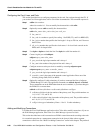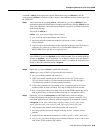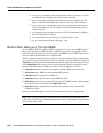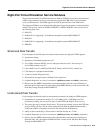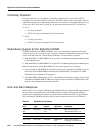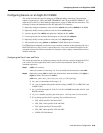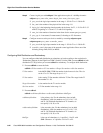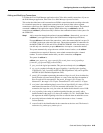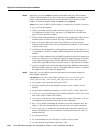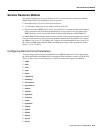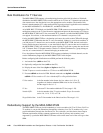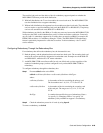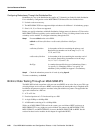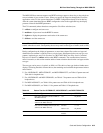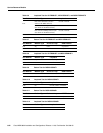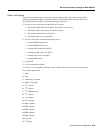
Eight-Port Circuit Emulation Service Modules
Cisco MGX 8850 Installation and Configuration, Release 1.1.00, Part Number 78-6186-02
6-46
Step 2 Optionally, you can use cnfcon to modify an individual connection. This command
requires a channel number. If you add a connection by using addcon, you do not need to
specify a channel number because the system automatically uses the next available
number. To obtain the channel number for cnfcon, execute dspcons.
cnfcon <port_num> <CDVT> <CLIP> <bufsize> <cbrclkmode> <isenable> <exttrigis>
• port_num is the port number.
• CDVT is a tolerable variation for the arrival time of cells. For T1, the range is
125–24000 micro seconds. For E1, the range is 125–26000 micro seconds. Both
require 125-microsecond increments.
• CLIP is CellLossIntegrationPeriod, an amount of time a connection can be in an error
condition before an alarm is declared. The range is 1000-65535 milli seconds.
• bufsize is the egress buffer size in bytes. These buffers are used for tolerating
variations in the cell delay. The size can be automatically computed, or you can enter
a specific size in bytes.
• cbrclkmode is the clock mode for a circuit emulation connection. The values are 1–3.
1 is synchronous. 2 is SRT. 3 is adaptive. SRT and adaptive are asynchronous clocking
schemes.
• isenable is a flag to enable the idle code (ABCD signalling bits) based cell suppression
feature on a connection. If you enable this feature, idle suppression logic is activated
so that suppression begins when valid idle ABCD bits are detected. This feature is
valid for only single DS0 connections. Possible values are 1 to enable and 2 to disable.
• exttrigis is an enable for an external idle suppression trigger. With this feature enabled,
the logic forcefully suppresses cells on a single DS0 connection. Enter a 1 to disable
idle suppression or a 2 to enable idle suppression.
Step 3 Optionally, you can configure connection parameters for the network segment of a
three-segment connection:
cnfswparms <chan_num> <mastership> <vpcflag> <conn_service_type> (=cos)
<route_priority> <max_cost> <restrict_trunk_type> <pcr> <mcr> <pct_util>
• chan_number is the connection in the range 32–279.
• mastership specifies the current endpoint as master or slave. 1=master. 2=slave
(default)
• vpcflag indicates whether the connection is a VPC or a VCC: 1=VPC, and 2=VCC.
• conn_service_type selects the type of service for the connection: 1=cbr, 2=vbr, 3 is not
used, 4=ubr, 5=atfr, 6=abrstd, and 7=abrfst.
• route_priority is the priority of the connection for re-routing. The range is 1–15 and
is meaningful only in relation to the priority of other connections.
• max_cost is a number establishing the maximum cost of the connection route. The
range is 1–255 and is meaningful only in relation to the cost of other connections.
• restrict_trunk_type is a number that specifies the type of trunk this connection can
traverse. The numbers are 1 for no restriction, 2 for terrestrial trunk only, and 3 for
satellite trunk only.
• pcr is the peak cell rate.
• mcr is the minimum cell rate. The range is 1–65535 cells per second.
• pct_util is the percent utilization in the range 1–100.



